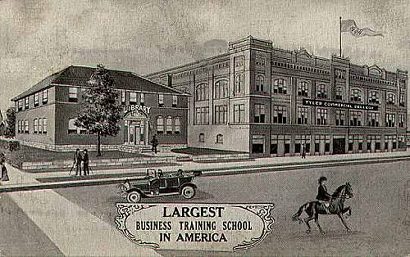|
|
On
Dec. 1, 1914, a 17-year-old teenager from Travis
County took the train from Austin
to Tyler
and enrolled at Tyler Commercial College.
More than a half-century later, leaning back in the chair of his
book-lined office while vigorously twiddling his thumbs on an ample
belly, Granddad told me that TCC is where he learned to type. He
acquired that skill on an Oliver, a machine Grandad said the college
touted as “the finest typewriter there ever was or would be.” Oh
well, no business school could be expected to get everything right.
Founded in Chicago by Thomas Oliver in 1895, the company produced
the nation’s first “visible print” typewriter, meaning the typist
could see what he or she typed while typing while hitting the keys
as opposed to other brands where the text could not be viewed during
the typing process. While its product might still have been considered
the state of the art in 1914, it went out of business in 1928. Well,
at least in the U.S. A British company bought the company and continued
to produce Olivers in the UK until 1958.
No matter the brand of typewriter he used, knowing how to type would
prove to be of vital importance to Grandad, who went on from the
business college in Smith
County to a long career as a newspaperman and freelance writer.
While Granddad had become pretty good at telling stories on a typewriter
or in person, other than laughing over the school’s belief in the
future of the Oliver typewriter, he never had much to say about
the time he spent nearly a century ago now in East
Texas.
Knowing him and the times, I imagine he boarded at one of several
rooming houses near the college. He had earlier aspired to be a
preacher, so he likely didn’t pose school staffers any disciplinary
problem.
For reasons he never explained to me, he stayed in school less than
a year. But what he learned about business must have been enough,
because by the summer of 1915 he was publishing a weekly newspaper
he had started at Big
Lake out in West Texas.
And thanks to TCC, he could type the articles he wrote -- on an
Oliver or some other machine.
Granddad
never got around to telling me any of his experiences in Tyler,
but TCC had the reputation of being one of the best business schools
in Texas at the time he attended classes
there. In 1914, the college already had more than 10,000 alumni.
The history of the college dates to the late 1890's, when C. L.
and Lockett Adair moved Whitesboro Teachers Normal College from
Grayson County
to Tyler
and merged it with Tyler College. Soon Henry Edwary Byrne and Frank
A. Glenn joined them in the venture and the college grew rapidly
in enrollment.
|
 |
Tyler Commercial
College
razed in 1965
1913 Postcard courtesy rootsweb.com/%7Etxpstcrd/ |
Student Body at
Morning Exercise
1914 Postcard courtesy rootsweb.com/%7Etxpstcrd/ |
|
TCC students attended
classes in a three-story 50,000-square foot building built a decade
earlier after fire destroyed the college’s first building in Tyler.
According to a 1914 postcard featuring TCC, the college was “The
Largest School of Bookkeeping, Business Training, Shorthand, Steno-typwriting,
Typewriting, Cotton Classing, Telegraphy, Business Administration,
and Finace in America.” It had 2,000 students and 20 teachers. “Positions
secured…Prepare to raise your own salary,” the advertising piece
offered.
Those attending TCC didn’t spend all their time sitting in a classroom
or studying. Every October, seven traincars of students went from
Tyler
to Dallas for the annual
TCC Day at the Texas State Fair.
Later, well after Granddad had moved on, the college developed a
well-respected petroleum geology department, world-renowned cotton
grading department, and a radio station so students could learn
about broadcasting. The college kept churning out students during
the East Texas oil boom
of the early 1930s and saw even more students when it offered defense-related
instruction during World
War II.
The school
stayed downtown until 1956, when the Rutherford Metropolitan School
of Dallas bought it. New
owner Tracy Rutherford moved the college from its 1904-vintage building
to a facility on South Broadway, where it remained in operation
for nearly another decade before finally closing for good, a victim
of the growth of junior colleges and four-year universities. The
old downtown building on aptly named College Street was razed in
1965 and a drive-in bank built on the site.
A key figure associated with the school was Henry Edward Byrne,
the only name my granddad ever mentioned in regard to TCC. Originally
from Mississippi, Byrne developed his own system of shorthand, soon
known in print ads as “the famous Byrne Shorthand.”
Byrne claimed a graduate of his shorthand course would be able to
take down words at 150 words a minute or the class would be free.
Whether my grandad took that course, which would have been handy
for his ambition for a career in journalism, the only way I ever
saw him write anything down was the old-fashioned way. Maybe Granddad
thought being able to type was good enough, which for him it turned
out to be.
© Mike Cox
"Texas Tales"
- October 4, 2012 column
|
| Books
by Mike Cox - Order Here |
|
|
